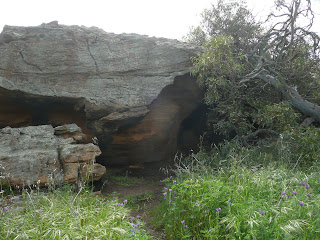 Everlasting Daisys
Everlasting DaisysWe headed east from Geraldton, firstly to Mullewa known for the trails of pink, white and yellow everlasting daisys, travelling along ridges with outstanding views across the green valleys and then on to Morawa, a delightful little town to base ourselves at the smallest van park we have stayed - 20 sites and 2 cabins, with spotless facilities and a bunch of friendly people.
This countryside brought back memories of our visit to the Amish country in the US State of Pennsylvania, however, there are no covered bridges, barn-raising or farmers tilling the soil with horse and farrow here in Aus!
Big Ears
This countryside brought back memories of our visit to the Amish country in the US State of Pennsylvania, however, there are no covered bridges, barn-raising or farmers tilling the soil with horse and farrow here in Aus!
Big Ears

First day toured south to the town of Perenjori, (Aboriginal word meaning 'water hole') and then looped back through Three Springs (home to the largest Talc mine in the Southern Hemisphere), and Mingenew the grain centre, (with the largest grain receiving facility also in the Southern Hemisphere) and also home to a giant wheat stalk sculpture, fondly known as Big Ears! These small towns are all charming with loads of history and a variety of wildflowers along the roads. Ade was disappointed that he couldn't find hot food (preferably a meat pie of course), after 1.30 pm! It feels like a step back in time or is it that we are really away from the big smoke?
Wreath Flower
Saturday we back tracked to Canna which had the best of mother natures displays. Everlasting and pom pom daisys, wattles (so many varieties), hakeas, myrtles, pea flowers, sturts desert pea, banksias, heaths, flannel flowers, kangaroo paws, grevilleas and fanciful names - featherflowers, red ink sundews, pixie mops and honeypots, to not even scratch the name calling surface!
We found the unique wreath flowers, which grow from a center of green and form pink and yellow flowers on the rim as they continue to grow in a distinctive circular shape. Tiny native orchids, cowslips, spider,custard, bird, vanilla, Queen of Sheba(just a few), as big as my smallest finger nail, and difficult to see in the bush. I hate to think how many I may have stepped on before realizing.

Cowslip Orchids
This particular area is only one of the hot spots for wildflowers and I'm sure we will be entranced by many more displays as we continue around the south west.. 

Time to head back to the coast, this time to Jurien Bay and maybe some warmer weather.




















